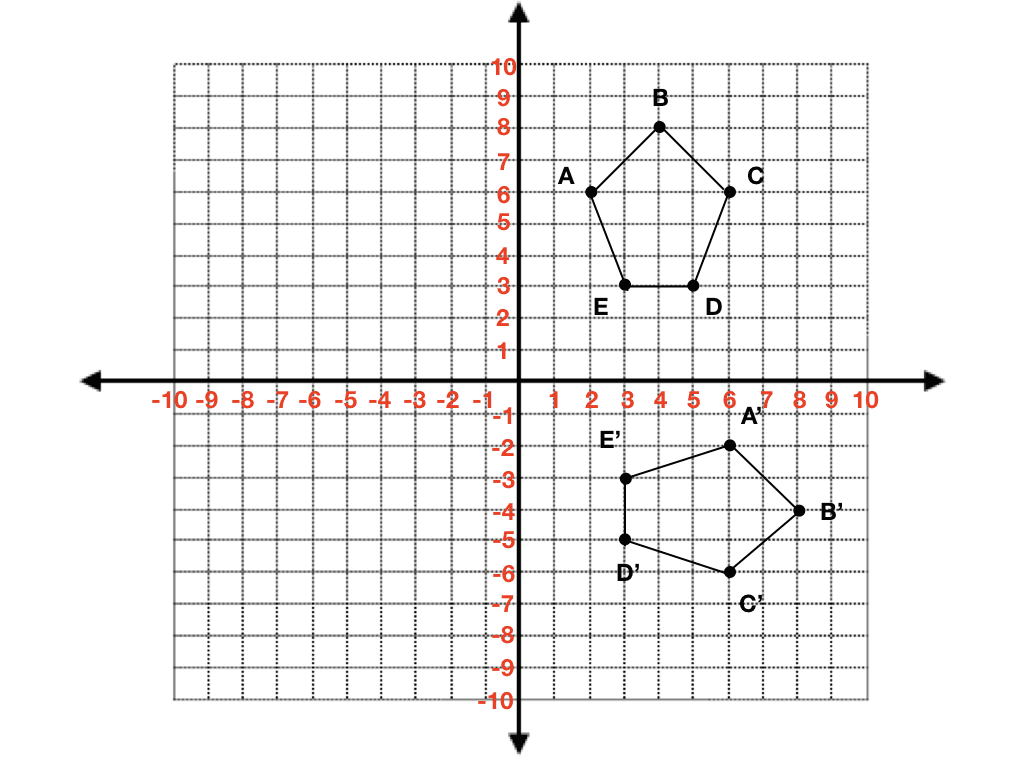
111.28.B.10.c Translations, Reflections, Rotations
Quiz by Quizalize - Grade 8 Math
Grade 8
Math (Archived)
Texas Essential Knowledge and Skills (TEKS)
Feel free to use or edit a copy
includes Teacher and Student dashboards
Measures 1 skill from
Measures 1 skill from
Track each student's skills and progress in your Mastery dashboards
With a free account, teachers can
- edit the questions
- save a copy for later
- start a class game
- automatically assign follow-up activities based on students’ scores
- assign as homework
- share a link with colleagues
- print as a bubble sheet
10 questions
Show answers
- Q1A pentagon is transformed on the coordinate plane. Which rule describes this transformation?(x,y) → (-y,x)(x,y) → (-x,y)(x,y) → (y,-x)(x,y) → (x,y – 6)300s8.10.C: Two-Dimensional Shapes
- Q2A rectangle is transformed on the coordinate plane. Which rule best describes this transformation?(x,y) →(x – 8, y)(x,y) → (x,-y)(x,y) → (x,y – 8)(x,y) → (-x,-y)300s8.10.C: Two-Dimensional Shapes
- Q3A trapezoid is reflected over the x-axis. What is the rule for this transformation?(x,y) → (2x , 2y)(x,y) → (x , -y)(x,y) → (-y , x)(x,y) → (x + 2, y – 8)300s8.10.C: Two-Dimensional Shapes
- Q4Square EFGH is rotated 180º counterclockwise about the origin to create square E’F’G’H’. Which rule describes this transformation?(x,y) → (-x , y)(x,y) → (-x,-y)(x,y) → (-y , x)(x,y) → (x – 6 , y + 8)300s8.10.C: Two-Dimensional Shapes
- Q5A triangle is reflected over the y-axis. Which rule best describes this transformation?(x,y) → (-x , y)(x,y) → (½ x , ½ y)(x,y) → (x + 5, y + 2)(x,y) → (y,-x)300s8.10.C: Two-Dimensional Shapes
- Q6Pentagon ABCDE is transformed on the coordinate plane to create pentagon A’B’C’D’E’. Which rule best describes this transformation?(x,y) → (10x,10y)(x,y) → (x – 10 , y – 11)(x,y) → (-10x,-10y)(x,y) →(x + 10 , y + 11)300s8.10.C: Two-Dimensional Shapes
- Q7Triangle QRS was translated 5 units up and 2 units left. Which rule best describes this translation?(x,y) → (-2x, 5y)(x,y) → (x+5, y–2)(x,y) → (x–2, y+5)(x,y) → (5x , -2y)300s8.10.C: Two-Dimensional Shapes
- Q8Triangle ABC is rotated 270º clockwise about the origin to create triangle A’B’C’. If the coordinates are as follows A(-4 , -5), B(-2 , -9), C(-1 , -2), where would B’ be located?B’(-9, -2)B’(2, -9)B’(9, -2)B’(2,9)300s8.10.C: Two-Dimensional Shapes
- Q9Rectangle J(1,1) K(1,4) L(5,4) M(5,1) is reflected across the y axis to create rectangle J’K’L’M’. What is the ordered pair for L’?L’(-4,5)L’ (-5,4)L’(-5,-4)L’ (5,-4)300s8.10.C: Two-Dimensional Shapes
- Q10Triangle X(3,4) Y(8,5) Z(5, 2) is translated using the rule (x+7, y–5) to create triangle X’Y’Z’. What is the ordered pair for Z’?Z’ (12,-3)Z’ (10,-1)Z’ (0,9)Z’ (15,0)300s8.10.C: Two-Dimensional Shapes
